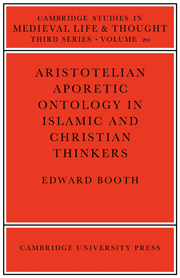Book contents
- Frontmatter
- Contents
- Preface
- Abbreviations
- 1 ARISTOTLE'S APORETIC ONTOLOGY AND THE RADICAL ARISTOTELIAN TRADITION
- 2 THE NEOPLATONIST INTERPRETATION OF ARISTOTLE'S ONTOLOGY
- 3 THE CHRISTIAN ARISTOTELIAN REACTION OF THE SIXTH CENTURY AND MONOTHEIST MODIFICATIONS TO THE NEOPLATONIST LEGACY
- 4 THE ARAB PERIPATETICS: AL-FĀRĀBĪ, IBN SĪNĀ AND IBN RUSHD; AND THE JEWISH PERIPATETICS: ABRAHAM BEN DAVID AND MOSES MAIMONIDES
- STASIMON: THE INTRODUCTION OF THE ‘NEW’ ARISTOTLE AND THE ARAB PERIPATETICS TO MEDIEVAL CHRISTENDOM
- 5 ALBERTUS MAGNUS: A LOGICO-EMANATIONIST FIGURE AS A MEANS OF ACCEPTING PERIPATETIC PHILOSOPHY INTO THE CHRISTIAN, PLATONIST TRADITION
- 6 THOMAS AQUINAS: THE ‘AUFHEBUNG’ OF RADICAL ARISTOTELIAN ONTOLOGY INTO A PSEUDODIONYSIAN-PROCLEAN ONTOLOGY OF ‘ESSE’
- Conclusion
- Appendix
- Bibliography
- Index
6 - THOMAS AQUINAS: THE ‘AUFHEBUNG’ OF RADICAL ARISTOTELIAN ONTOLOGY INTO A PSEUDODIONYSIAN-PROCLEAN ONTOLOGY OF ‘ESSE’
Published online by Cambridge University Press: 05 November 2011
- Frontmatter
- Contents
- Preface
- Abbreviations
- 1 ARISTOTLE'S APORETIC ONTOLOGY AND THE RADICAL ARISTOTELIAN TRADITION
- 2 THE NEOPLATONIST INTERPRETATION OF ARISTOTLE'S ONTOLOGY
- 3 THE CHRISTIAN ARISTOTELIAN REACTION OF THE SIXTH CENTURY AND MONOTHEIST MODIFICATIONS TO THE NEOPLATONIST LEGACY
- 4 THE ARAB PERIPATETICS: AL-FĀRĀBĪ, IBN SĪNĀ AND IBN RUSHD; AND THE JEWISH PERIPATETICS: ABRAHAM BEN DAVID AND MOSES MAIMONIDES
- STASIMON: THE INTRODUCTION OF THE ‘NEW’ ARISTOTLE AND THE ARAB PERIPATETICS TO MEDIEVAL CHRISTENDOM
- 5 ALBERTUS MAGNUS: A LOGICO-EMANATIONIST FIGURE AS A MEANS OF ACCEPTING PERIPATETIC PHILOSOPHY INTO THE CHRISTIAN, PLATONIST TRADITION
- 6 THOMAS AQUINAS: THE ‘AUFHEBUNG’ OF RADICAL ARISTOTELIAN ONTOLOGY INTO A PSEUDODIONYSIAN-PROCLEAN ONTOLOGY OF ‘ESSE’
- Conclusion
- Appendix
- Bibliography
- Index
Summary
Outlived by his master, Albert, Thomas Aquinas (1224/5–1274) – the ‘doctor angelicus’ – confronted the same potential anarchy of thought, and produced a philosophical figure which had the same eirenic intention as Albert's. Thomas's thought developed from the basis of Albert's; though it is more refined, more articulate, greater in volume and range, and more calm. Its apparent simplicity is that of problems resolved; his own aporetic of objection and response does not, like Aristotle's metaphysics, display the process of intense groping for a final solution, which obstinately refuses to come forward, but is the exposition of something already explained, or the exploration of the virtualities of a position already taken up. To use on him the model of ‘influence of earlier writers’ simply because he quotes or uses their ideas is quite inappropriate. Far nearer the facts is a series of paintings of his ‘triumph’, which show a calm but deeply alert Thomas, surrounded by philosophers as well as ecclesiastical writers, who, whilst they may be ministering their works to him, are themselves illumined by the radiance which is diffused from him. Even more appropriate for his work is the categorisation already applied to Albert's: creative response; and not least is it appropriate because whilst he had before him the generously conceived, though somewhat aggressively carried out, comprehensive figure of Albert, his own figure significantly differs from it.
- Type
- Chapter
- Information
- Aristotelian Aporetic Ontology in Islamic and Christian Thinkers , pp. 205 - 267Publisher: Cambridge University PressPrint publication year: 1983
- 1
- Cited by



